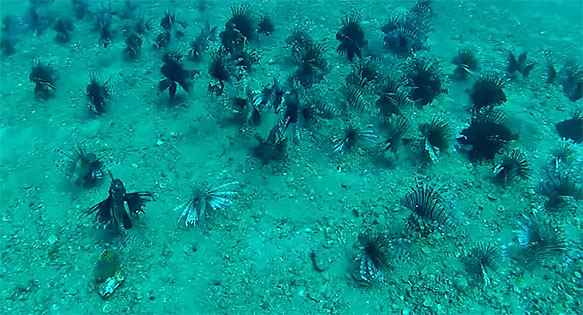The story of the invasive lionfish in the Atlantic is old news. Still, if you didn’t know what a truly invasive species really looks like in the environment, if you don’t understand the out-of-control impact an invasive lionfish can have, Alex Fogg’s video from a lionfish derby of the coast of Pensacola, FL, sums it up very well.
I hope you cheered with every successful kill; Fogg ends his video noting that they removed 200 Lionfish from just this one location (all fish going to research or turned into food at local restaurants). Let this video serve as yet another reminder to never release your pet fish into the wild.
“This is why we can’t have nice things!”
Video Credit: Alex Fogg






I have a problem with the remark that says (to get to this page and video) “See exactly why you should never release your pets into the wild!” If the lionfish found in the Caribbean now were “pets”, then they would have invaded many years ago as unknowing aquarium owners have been releasing these fish as well as others for many, many years but we did not see them spreading until the later 90’s. The invasion most likely got started when “in 1992, Hurricane Andrew destroyed an aquarium in Florida. Lionfish from the aquarium were set free in the Atlantic Ocean”. They were released as a group and therefore it makes sense that this is where the lionfish invasions got it’s start and not from “pets” released singly here and there where finding each other would be almost impossible. The python invasion in the Everglades is from pets but this one it would not make sense.
Robyn, Ret Talbot published several articles in our July/August 2014 issue of CORAL regarding the invasive Lionfish presence in the Atlantic. http://www.reef2rainforest.com/2014/07/07/coral-magazine-table-of-contents-julaug-2014/
One of those articles, “Origins of a biological calamity”, goes into great depth regarding just exactly where the lionfish came from. Regarding the “Hurricane Andrew” hypothesis, Talbot wrote:
“In 1995, a story by Walter Courtenay, a fisheries biologist and professor emeritus at Florida Atlantic University in Boca Raton, appeared, linking Hurricane Andrew and the lionfishes in a publication of the American Fisheries Society. But reporting in Science Magazine in 2010, Courtenay ‘put this idea to rest.’ He explained that his information was secondhand and that he was never able to confirm that the destruction of the aquarium, which may not have even happened, was linked to the subsequent lionfish invasion. Like most of the scientists interviewed for this story, Courtenay believes that the lionfish invasion is most likely the result of somoene in the aquarium hobby releasing lionfishes into the wild. Courtenay attempted to set the record straight after 15 years because he believed it was both ‘unfortunate’ and detrimental that the misinformation in his story persisted for so long. Unfortunately, four years after the Science Magazine article, Hurricane Andrew continues to be cited by many as the origin of the western Atlantic lionfish invasion.
“Finally, it’s important to remember that, according to James Morris, Jr., an ecologist with NOAA’s Center for Coastal Fisheries and Habitat Research in Beaufort, North Carolina, the first documented lionfish sighting off the coast of Florida was in 1985 in Dania, Broward County, Florida-years before either Hurricane Andrew or the building of the Bahamas resort.”